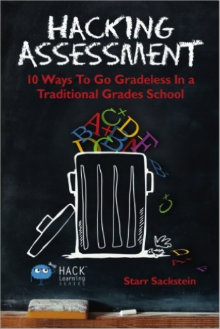Hacking Assessment: 10 Ways to Go Gradeless
Hacking Assessment: 10 Ways to Go Gradeless in a Traditional Grades School
By Starr Sackstein
(Times 10 Publications, 2015 – Learn more)

As teachers we all know how time consuming it is to grade every assignment, and just like Starr Sackstein, author of Hacking Assessment: 10 Ways To Go Gradeless In a Traditional Grades School, says:
The more time we spend looking at the same assignment, the less consistent our opinions become. The students at the top of the stack usually get the best of us, while those at the bottom could potentially get a cursory read.” (p. 110)
Every teacher can relate to this. It happens every time we have a performance task. I get so excited for the first 20 assignments and then dread the rest, and the last 10 assignments just get a glance.

How and why a gradeless classroom works
This book provided me with resources and guidance on how I can show evidence that a gradeless classroom works. As teachers we want our students to want to learn and not just ask what grade they received. I definitely want to change the mindset in my classroom.
The cool thing about this book is that it first provides 10 ways to implement a gradeless classroom and then suggests ways to possibly invest other teachers and hopefully the whole school in going gradeless.
Within the 10 ways, Sackstein organizes each hack (chapter) by including in order:
- the problem
- the hack
- what you can do tomorrow
- steps for full implementation
- overcoming pushback
- the hack in action
- and reflective questions on your own practice
I love the section about overcoming pushback because I can already anticipate the arguments against a gradeless classroom from teachers, administrators, parents, and students. Sackstein provides answers for pushback to invest all stakeholders. I’m also impressed with the pushback section because it definitely shows that Sackstein thought about concerns that others may have.
For example, she answers the question “Why change a system that isn’t broken?” by asking us to think about “…how much the world has changed in the last hundred years.” She suggests generating “a list of ways that a 19th-century system doesn’t prepare kids for the creativity and critical thinking required of the 21st century.” (pg. 28)
The section on what you can do tomorrow allows you to start at any time of the year so that you don’t have to wait until the beginning of the school year. Towards the end of the book, there is a resource page so that you can continue to read about hacking learning.
A couple of concerns
As I read the book, I did have many questions about the specifics. For example, I would love to have more examples catering to middle school students. The majority of the hacks in action were AP classes or high school classes, which made me think that it will be way more challenging for middle school students and teachers to achieve a gradeless classroom.
When Sackstein started implementing a gradeless classroom, she states, “Eventually students told me that not worrying about grades made them more excited and eager to try things.” I would love to see how this is implemented successfully in an urban middle school classroom. The 10 Ways also seemed out of order to me which makes me believe that you can start at any point in the book.
Some things I learned
From the book I learned that with a gradeless classroom, students have more voice in how and what they learn. Students have to learn how to reflect and provide self-evaluation if the schools do mandate grades. Students are expected to show and describe mastery and to implement it on an independent assignment. Students are also provided with more feedback, and Sackstein includes the SE2R feedback model: summarize, explain, redirect, resubmit.
Gradeless classrooms also encourage one-on-one conferences with students so that they are aware of their learning process and there’s never a question about what they’ve learned in class. With the conferences teachers are able to establish relationships with their students and allow for check-ins every week. These are some of the many positive outcomes from going gradeless.
Sackstein can get you started
This book is definitely a great book to start with if you’re curious about changing the way you grade. Sackstein stresses the importance of showing mastery and allowing students to take control of their learning. Sackstein also reminds readers repeatedly that going gradeless will take time, and that we need to continue with the practice to see change rather than just giving in because people are complaining about it.
Now I feel like I’m ready to persuade my administrators to focus on student growth rather than letter grades. And then, maybe I’ll get that multi-year contract. We shall see.
Toni Rose Deanon recently finished her 6th year of teaching middle school English. She has taught in Atlanta, GA, Baltimore, MD, and Washington, DC. She earned degrees from the University of Georgia (BS. Ed.) and Georgia State University (M.Ed.) During the summer, she is a Teacher Development Coach for a Teaching Residency program. She absolutely loves reading and sharing her love of reading with students.


































I’m so glad you found the book useful. Although most of my work is done in high school, if you check out the Teachers Throwing Out Grades group in FB, you can network with many middle school teachers who are trying out the practice. Good luck. Can’t wait to hear how it goes. Thanks for reading